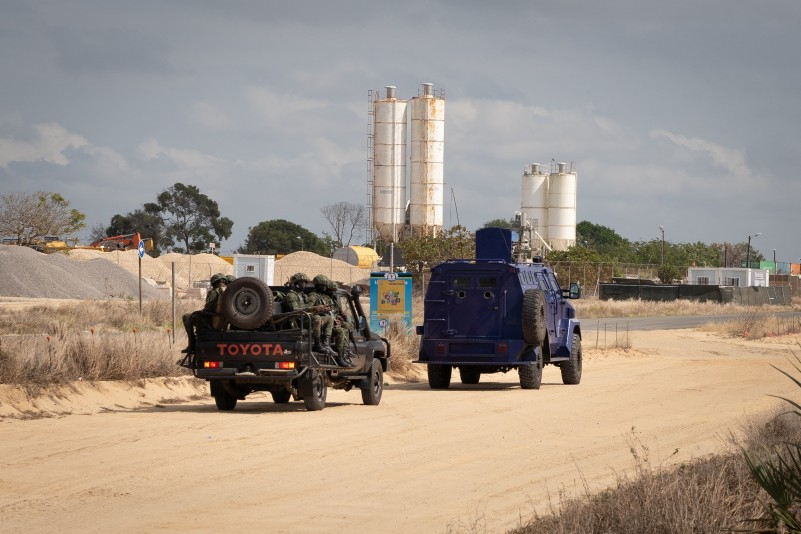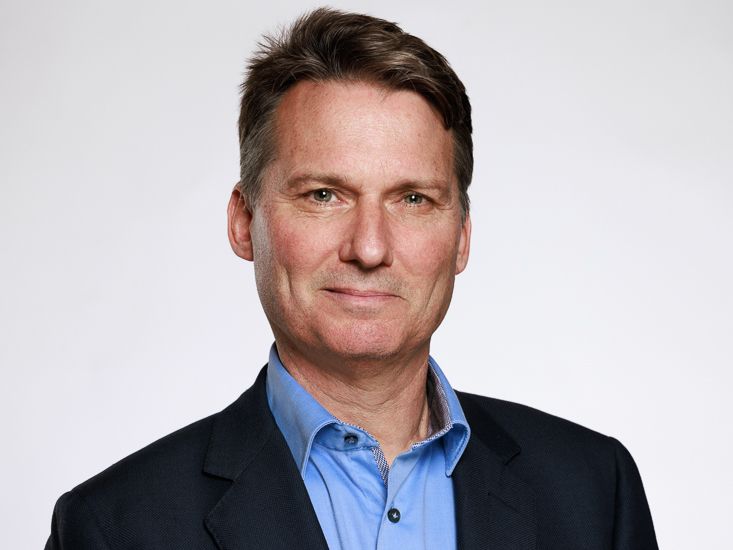Share post now
Article
Mobilising private finance: many open questions
27.03.2023,
Since the UN Conference on Financing for Development in Addis Ababa in 2015, the international community has been almost at one in repeating the mantra: only by mobilising private finance will it be possible to fund the Sustainable Development Goals.

Soldiers from Rwanda protect a facility at Total's gas production project in Cabo Delgado, Mozambique.
© Simon Wohlfahrt/AFP/Keystone
In the wake of the COVID-19 crisis, SDG funding gap was reassessed in 2021 at USD 3.9 trillion (3,900 billion). In that same year, Official Development Assistance (ODA) totalled a (record) USD 185.9 billion. Under the Paris Agreement, developed countries confirmed their commitment to mobilising USD 100 billion in climate finance per year as of 2020. The sum raised for that purpose in 2021 was USD 83 billion. Thus, there is a shortfall, and it is abysmal. So far, the reflex at both the multilateral and bilateral levels has been to look to private finance in the hope of filling this gap.
What is the effective contribution of private funds towards reducing the funding gap for the SDGs and climate action? What mechanisms exist for raising such funds (leveraging mechanisms)? What are the challenges being faced? It is sometimes a good idea to pause and take stock of the real situation. That was the purpose of a recent OECD report, which answers some questions, but also leaves several key ones open:
How much has been mobilised?
- The annual average for 2018-2020 was USD 48.6 billion mobilised from the private sector through official development finance interventions. In 2012, that amount was USD 15.3 billion. The OECD itself describes this outcome as "modest" and "below expectations".
In which countries are investments being made?
- 35% of the private finance was earmarked for Africa (USD 16.5 billion/year, including USD 3.4 billion for gas megaprojects in Mozambique alone), with Asia in 2nd place with USD 13.5 billion, including USD 3.3 billion for India alone.
- The top seven beneficiary countries are Mozambique, India, China (PRC), Turkey and Egypt, followed by Brazil and Ukraine.
How did poorer countries fare?
- 87% of these funds went to Middle Income Countries (MICs), i.e., developing countries with a "low risk profile".
- 18% of the private finance mobilised went to Least Developed Countries (LDCs), with two thirds going to just five countries (Mozambique, Bangladesh, Uganda, Guinea and Angola). These relatively large amounts are driven by the Liquefied Natural Gas (LNG) megaprojects in Mozambique.
In which sectors?
- In terms of beneficiary sectors, almost two-thirds of the private finance (90%) went into infrastructure and economic and production services projects - the principal subsectors being banking and business services (36%), industry, mining and construction (28%) and energy (18%) - while a mere 7% went to social infrastructure and services, including education (1%), healthcare and population (2%) and water and sanitation (3%).
Who is mobilising how much?
- 69% of the private finance was mobilised by multilateral development banks. The World Bank Group alone accounts for 34% of this mobilisation, followed by the European Bank for Reconstruction and Development (EBRD), the European Investment Bank (EIB) and the Asian Development Bank (ADB). Except for the EIB, Switzerland is a member of all these multilateral development banks and, to meet international targets in the future, plans to book the private finance mobilised by these banks, including for climate action, in a manner proportional to its capital stakes in them.
- 25% was mobilised by bilateral institutions, predominantly Development Finance Institutions (DFIs), including the Swiss Investment Fund for Emerging Markets (SIFEM), which occupies 11th place with an average of CHF 42 million in private finance mobilised per year. Multilateral institutions supported by Switzerland contributed 5% of private finance, among them, the Private Infrastructure Development Group (PIDG), the Global Environment Facility (GEF), and the Green Climate Fund (GCF).
How much went to climate action?
- Some 32% of all private finance mobilised in 2018-20, or USD 15.5 billion per year, went to climate mitigation and/or adaptation. Despite rising from USD 1.9 billion in 2018 to USD 4.4 billion in 2020, the share of private funds mobilised for adaptation represents an annual average of just 4% of the total. On average for the 2016-2020 period, 86% of the private funds mobilised for climate action went to emission reduction (mitigation) projects, of which 53% for energy alone.
The OECD report underscores that according to public providers and private players directly involved in financing, the "modest results" are described as largely due to the challenges they face when co-investing in developing countries, namely: high risk perceived; low level of return on investment portfolios; lack of "bankable"/sizeable project pipelines and investment opportunities; and lack of "financial innovation" in institutions' portfolios.
It goes on to note that the risk perceived by private investors is especially high in the countries and sectors most in need, in terms of projects' commercial viability and return profile, even for projects with impact goals. "Hence the small share of private finance mobilised in these contexts. Similarly, the low levels of financial returns, the very small size of investment opportunities and, more generally, the lack of incentives for private actors to invest in climate adaptation explain that it accounts for only 4% of providers' total mobilised private finance."
Despite the modest results highlighted by the report, governments and development banks have stated that they will continue their efforts to mobilise more private finance, among other things, by:
- making greater use of guarantees and other "innovative mechanisms";
- funding new blended finance vehicles or programmes specifically set up to mobilise private investments, and;
- undertaking more profound model changes (new mandate and/or business model).
This well-nigh frenetic quest for private finance for development and climate action nevertheless raises a series of (systemic) questions, whose relevance the OECD report recalls, though without providing answers: in view of the level and complexity of the actual or perceived risks for private investors in Least Developed Countries (LDCs), to what extent can private finance mobilisation represent a credible and substantial alternative to official development assistance (ODA)? How far is it possible or even desirable, to mobilise private finance in sectors where the financial return is – and will, by nature, remain – low or even almost non-existent, especially as it is a matter of guaranteeing universal and equitable access to goods and services that are indispensable to the population (including education, healthcare, clean water and sanitation)? To what extent, also for reasons of financial return, are climate adaptation projects financeable by private investors? More broadly, to what extent do large projects co-funded by private investors ensure observance of the principles of development effectiveness, especially in terms of consulting the people affected? Finally, and no less importantly, what is the potential impact of a substantial increase in private investment, as desired by the various players, on the indebtedness of "beneficiary" countries?
Dreams and reality do not always coincide.
Private funds for development and climate adaptation? Example of LNG megaprojects in Mozambique
Following the discovery of huge natural gas reserves in Mozambique, multinationals including TotalEnergies, ExxonMobil, Italy's Eni and Japan's Mitsui drew up plans to build massive liquefied natural gas (LNG) projects that would include offshore extraction, an underwater pipeline and an onshore processing plant. The project is co-funded by the African Development Bank (AfDB) and is the largest foreign direct investment (FDI) to date and the most substantial project financing in Africa. These projects are expected to make Mozambique the world's 3rd largest LNG supplier. Components of the project, including the resettlement of the people affected, are being presented as climate change adaptation measures. After a threat to these projects from an Islamist insurgency in the Cabo Delgado region, the EU announced plans to scale up its financial backing for a military mission in Mozambique to ensure that the gas projects come on stream as soon as possible, so as to reduce the EU's dependence on Russian gas.
